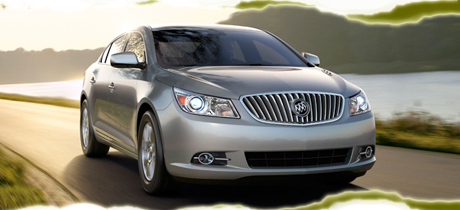|

2012
Buick LaCrosse with eAssist
by Martha Hindes
Creating a Buick for all tastes has to be a balancing act. Its traditional buyer is likely to an upmarket achiever, maybe a little more on the conservative side. But picking up some “niche” customers from the now defunct but sportier Pontiac brand could require some “zing” as well, without overloading the “bling.” Then add in millions of auto intenders in China who consider Buick the most desired auto on the planet thanks to the company's presence there for years. Does the 2012 Buick LaCrosse family sedan serve all three?
We'll answer that with another question. Does better fuel efficiency transcend some other requirements? In today's volatile gasoline price environment, with all the stability of a yo-yo on speed, how could it not? Just about every auto now made by every automaker is being tweaked for better fuel economy. And since fuel economy is becoming one of the most shopped items on the checklist, going for mileage improvement has to be a no brainer.
The biggest gain -- and news -- of the 2012 LaCrosse is something not normally seen, unless by mechanics or gearheads who always seem to pop the engine hood for a peek. For this model year, Buick added what it calls an “eAssist light electrification” engine, designed to up fuel economy with the help of an electric battery pack in its innards. (It's reminiscent of some early semi-hybrid autos from Buick parent, General Motors. Buick, however, astutely avoids the term.)
The guts of Buick's eAssist system is an all-new 2.4-liter, 182-horsepower, four-cylinder “Ecotec” engine earning miles-per-gallon ratings of 25 city and 36 highway. That's a quarter better than the previous 2.4-liter engine it replaces -- a huge improvement by anyone's standard. (And, to get a tad techy, mileage also is improved with movable air intake shutters that cause air to slip aerodynamically around rather than through the engine to eliminate drag. It's the same system added to the new Chevrolet Malibu.)
For those who want to start with more power underfoot, Buick offers a 3.6-liter, 303-horsepower V-6 (17/27-MPG) that can use E85 flexible fuel. That’s a mix of 85 percent plant-based ethanol to 15 percent gasoline. (Think of putting a bushel of processed plants into the gas tank instead of imported oil from the Middle East.)
With those obvious benefits on the mileage side, we can appreciate the appearance of the front- or all-wheel-drive, midsize upscale LaCrosse even more. While it's designed to carry five in comfort, the exterior doesn't lag in the styling sense. Swoopy lines trail rearward for a smooth, sophisticated appearance. A dominant, bold nose with the signature vertically striped grille between a broad sweep of headlamps lends an upscale tailored look to the front, without losing its aggressive character.
We have one holdover “huh” reaction with the LaCrosse's outside appearance. Decades ago, when Buicks seemed more like heavyweight land ships, the company adopted those famous “portholes” that made them instantly identifiable. At the time they related to the size engines under the hood (three portholes on each side represented a six cylinder, for example). Now it's a trim element only, positioned toward the top of the hood rather than on the front flanks. With no standard relationship to engine size any longer, they seem oddly out of place.
We can't criticize the interior, however. There are quality materials and a striking instrument panel design that incorporates a sense of interwoven functions that give it a rather oriental character. (The LaCrosse's exterior design is North American; the interior's from GM's Chinese design facility.)
Among improvements for 2012, besides the powerplant main event, there's available Buick “IntelliLink” that mates Bluetooth or USB connectivity with other high tech functions -- giving access to such amenities as PANDORA Internet Radio and Stitcher SmartRadio.
The driver information center is enhanced and rear-vision camera becomes available without a navigation system.
While not overly aggressive, we found the LaCrosse handled easily on the road, with a sense of confidence behind the wheel when pushed into turns. It suggested sheer comfort if we'd gone for a lengthy drive.
Among safety advances, besides accident prevention and collision protection systems, is a “stolen vehicle slowdown” that works with GM's OnStar communications system. It remotely turns off power to a stolen vehicle during a police chase.
Expect to pay a base of $31,045 if the LaCrosse suits your fancy, or $39,695 for a loaded Touring model. That's in the range of other premium family sedans.
Going back to our original question, how well does the LaCrosse suit three decidedly different audiences? Considering it was designed on three different continents -- North America, Europe and Asia, as Buick proudly points out -- and is manufactured in Kansas City, Kansas, we think it probably manages to snag all three.
For more info on Buick brands, click here.
|